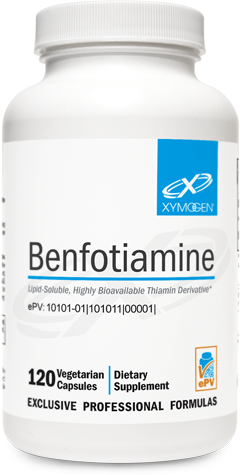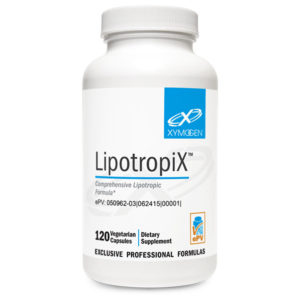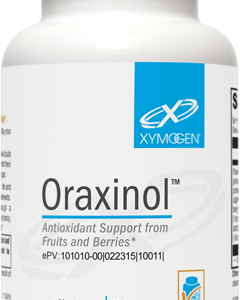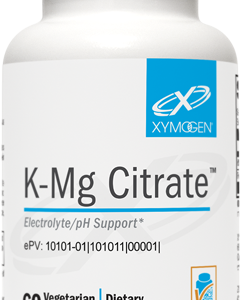Scientific Information/Data
The excellent pharmacokinetic profile of lipid-soluble benfotiamine (S-benzoylthiamine O-monophosphate) is the reason why many practitioners select it in preference to other forms of supplemental thiamin, especially for protocols requiring high levels of the B vitamin. Its effectiveness, however, has been demonstrated even in low doses (i.e. 150 mg/d).[1] As compared to thiamin hydrochloride administration, maximum plasma levels are approximately five times higher and bioavailability is, at maximum, approximately 3.6 times as high. These plasma levels are also better than lipophilic thiamin derivatives.[2]
Pathways of Glucose-Metabolite–Induced Damage High intracellular sugars can lead to an accumulation of intermediate metabolic products. These metabolic products activate certain pathways.[3,4] These pathways are: (1) polyol pathway flux; (2) increased formation of AGEs (advanced glycation end-products);
(3) increased expression of the receptor for AGEs (RAGEs) and its activating ligands; (4) activation of protein kinase C (PKC) isoforms; and (5) overactivity of the hexosamine pathway.[4] Together, these mechanisms can impact vascular tissue and target particularly susceptible capillary endothelial cells of the retina, mesangial cells in the renal glomerulus, neuronal cells, and Schwann cells.*[3-7]
Benfotiamine Supports Diversion to Different Pathway
Benfotiamine has been shown to enhance the activity of transketolase, an enzyme that catalyzes the conversion of harmful glucose- intermediate metabolites in the pentose phosphate pathway.[4-7] In vitro research showed treatment with benfotiamine had an impressive effect on transketolase activity (454% increase from control).[5] Researchers further indicated that increasing transketolase activity supports the diversion of intermediate metabolites away from three of the major pathways (including AGE formation) discussed above. [5] Benfotiamine was shown to have a positive influence on AGE formation and PKC activity. It is thought to prevent NF-kappaB activation in the rat retina as well as inhibit change in the number of retinal acellular capillary segments.*[5] This research has been supported by a human pilot study wherein subjects given benfotiamine (600 mg/d) plus alpha-lipoic acid (1200 mg/d) demonstrated healthy changes in AGE formation, monocyte hexosamine-modified proteins, and prostacyclin synthase activity.*[8]
Nerve Tissue Health Microvasculature feeding peripheral nerves can be affected by the pathways discussed herein. Furthermore, lower AGE formation is associated with healthier nerve tissue. The role of benfotiamine in diverting glucose metabolites to a less harmful metabolic pathway may well be the underlying reason it has been used successfully in Germany for over a decade to support nerve health. Results suggest that benfotiamine is most effective in large doses (320-600 mg/d), although effectiveness is still achieved in smaller daily dosages (150 mg/d).*[1,9,10]
References
- Winkler G, Pál B, Nagybéganyi E, et al. Effectiveness of different benfotiamine dosage regimens in the treatment of painful diabetic neuropathy. Arzneimittelforschung. 1999 Mar;49(3):220-24. [PMID: 10219465]
- Loew D. Pharmacokinetics of thiamine derivatives especially of benfotiamine. Int J Clin Pharmacol Ther. 1996 Feb; 34(2):47-50. [PMID: 8929745]
- Brownlee M. The pathobiology of diabetic complications: a unifying mechanism. Diabetes. 2005 Jun;54(6):1615-25. [PMID: 15919781]
- Giacco F, Brownlee M. Oxidative stress and diabetic complications. Circ Res. 2010 Oct 29;107(9):1058-70. [PMID: 21030723]
- Hammes HP, Du X, Edelstein D, et al. Benfotiamine blocks three major pathways of hyperglycemic damage and prevents experimental diabetic retinopathy. Nat Med. 2003 Mar;9(3):294-99. [PMID: 12592403]
- Balakumar P, Rohilla A, Krishan P, et al. The multifaceted therapeutic potential of benfotiamine. Pharmacol Res. 2010 Jun;61(6):482-88. [PMID: 20188835]
- Thornalley PJ. The potential role of thiamine (vitamin B1) in diabetic complications. Curr Diabetes Rev. 2005 Aug;1(3):287-98. [PMID: 18220605]
- Du X, Edelstein D, Brownlee M. Oral benfotiamine plus alpha-lipoic acid normalises complication-causing pathways in type 1 diabetes. Diabetologia. 2008 Oct;51(10):1930-32. [PMID: 18663426]
- Haupt E, Ledermann H, Köpcke W. Benfotiamine in the treatment of diabetic polyneuropathy—a three-week randomized, controlled pilot study (BEDIP study). Int J Clin Pharmacol Ther. 2005 Feb;43(2):71-77. [PMID: 15726875]
- Stracke H, Gaus W, Achenbach U, et al. Benfotiamine in diabetic polyneuropathy (BENDIP): results of a randomised, double blind, placebo-controlled clinical study. Exp Clin Endocrinol Diabetes. 2008 Nov;116(10):600-05. [PMID: 18473286]
*These statements have not been evaluated by the Food and Drug Administration. This product is not intended to diagnose, treat, cure, or prevent any disease.






